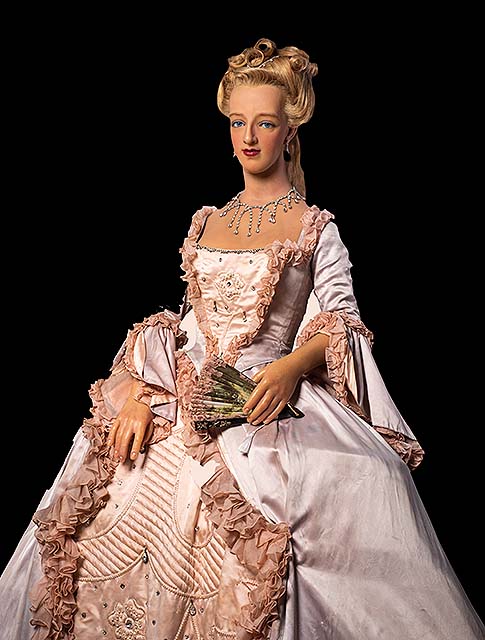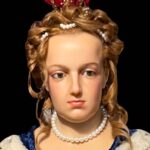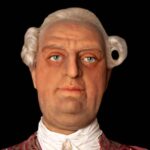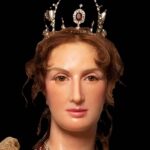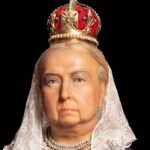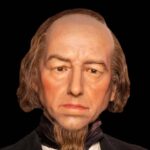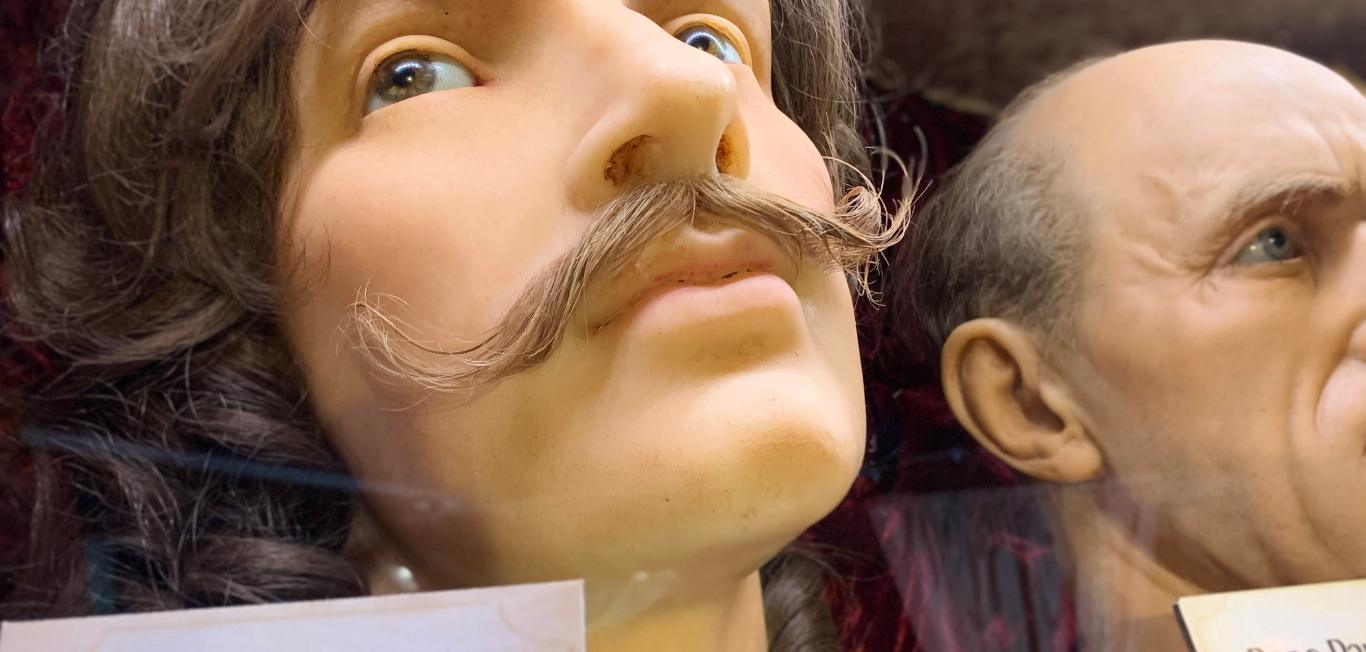Who Was Marie Antoinette?
The lady credited with saying “Let them eat cake!” in response to her starving citizens, Queen Marie Antoinette has become a hated, mythic, and hilarious figure in the history of the French Revolution. Beyond this incredibly dense comment, Marie Antoinette is remembered as an extravagant spender and a fashion trendsetter. However, most know about Marie Antoinette because of her eventual beheading during the French Revolution.
Queen Marie Antoinette, born Maria Antonia Josepha Joanna von Österreich-Lothringen in Austria, lived a life of luxury and opulence in Versailles that immensely impacted fashion and style, being referred to by some as the world’s first influencer. However, the impoverished common people in France did not look at these trends with the adoration that modern influencers receive and instead saw them as an indication of her hateful obliviousness to the difficulties that they were going through.
Interesting Facts About Marie Antoinette
Marie Antoinette married Louis XVI at only 14 years old.
As was common with royals of the time, Marie Antoinette and Louis XVI were engaged in order to seal an alliance, in this case between Antoinette’s home of Austria and Louis’ of France.
It is said that she once donned a battleship in her hair.
The Marie Antoinette era included many exuberant fashion trends, but Antoinette’s hairstyles often took the cake (pun intended). Antoinette’s royal hairdresser, Léonard Autié, would supposedly build her hair up to an impressive height of four feet and dress it with everything from feathers and pearls to, yes, an actual miniature battleship.
Incest was rumored to be among the crimes that resulted in Antoinette’s beheading.
The Revolutionary Tribunal accused the former queen of many trumped-up crimes, including high treason and sexual promiscuity. However, the worst might have been when her son Louis-Charles was allegedly forced to testify that Antoinette had assaulted him.
The portraits of Marie Antoinette were done by a female artist.
It is unsurprising that Marie Antoinette, being a fashionista and lover of beautiful things, had her portrait painted about 30 times. However, it is quite impressive to know that these portraits were all done by the same woman: Élisabeth Louise Vigée Le Brun. Vigée Le Brun and Antoinette would become lifelong friends during the many years that it took to complete all these portraits.
There is a U.S. city named after Marie Antoinette.
The city of Marietta, Ohio was named after the queen as a way for the Americans to honor France, which was crucial in helping the revolutionaries win independence from Britain.
Early Years
Marie Antoinette was born on November 2, 1755, in Vienna to Holy Roman Emperor Francis I and Maria Theresa of Austria, making her royalty from birth. She was the youngest of 15 children to the couple and was the last in a long line who became influential political figures all around Europe, especially during the Hapsburg Empire. Maria Theresa secured advantageous marriages for all 11 of her daughters, including Maria Christina to the regent of the Austrian Netherlands, Maria Amalia to the prince of Parma and Maria Carolina to King Ferdinand of Naples, but none were as famous as Marie Antoinette’s would become.
DID YOU KNOW?
Marie Antoinette was the youngest of 15 children.
In 1748, several years before Antoinette was born, the Treaty of Aix-la-Chapelle was signed by Austria and France to end the nearly 150 years of conflict between the two countries. However, this treaty was not considered enough to secure the alliance and so, in 1769, when Marie Antoinette was only 14 years old, after negotiations that began when Antoinette was 11 years old and the sudden deaths of her two older sisters who normally would have been married first, Prince Louis XVI of France and Marie Antoinette of Austria became engaged.
After successfully securing powerful marriages for the rest of her daughters, Antoinette’s mother Maria Theresa set about ensuring that Marie Antoinette would be the perfect wife and queen for France. This process started with Antoinette hurriedly starting lessons in French language and customs and ended in a symbolic handover of Antoinette to France on May 7, 1769. This handover included Antoinette leaving behind all of her Austrian links, including her clothing, servants, and her dog.
Finally, in May of the following year, 1770, Marie Antoinette of Austria became Queen Marie Antoinette of France when she married Louis XVI and made her permanent home at Versailles in France.
Personal Life
The personal life of Marie Antoinette was not always easy for the queen. Her marriage to Louis XVI was arranged when she was young as an entirely political decision, leaving her and the king with little in common and even less chemistry. Although the pair were married in 1770, they would not actually consummate the marriage for seven more years due to a medical condition that rendered Louis XVI impotent. In fact, Maria Theresa, Antoinette’s mother, eventually took it upon herself to get involved by sending Antoinette’s brother Emperor Joseph II to intervene. However odd, it clearly had an effect, as over the next nine years, Antoinette would mother her and Louis XVI’s four children: Marie-Thérèse-Charlotte in 1778, Louis-Joseph in 1781, Louis-Charles in 1785 and Sophie-Béatrix in 1786.
Beyond her marriage, Marie Antoinette, Queen of France, was never actually given a political role. She had a very limited number of official duties, so she filled her time with socializing and indulging in extravagances. These extravagances, including her massive and impressive hairstyles, opulent dresses, and numerous cakes, would become what Antoinette is most known for today. It was also her indulgence in such things that would create the deep hatred for Antoinette that eventually led to her death during the French Revolution.
DID YOU KNOW?
Marie Antoinette filled her time with socializing and indulging in extravagances
Later Years and the French Revolution
The later years of Marie Antoinette’s life were not the best for the opulent queen. The 18th century was a time of many revolts, and France would be no different. Inspired by the American Revolution, the French people saw the extravagance of Versailles and Marie Antoinette’s lifestyle as proof that she and the rest of the royals were unfit to rule and in fact treasonously oblivious to their plights. Antoinette’s unpopularity grew at the end of the 18th century through a series of smear campaigns by the press, including being given the nickname “Madame Veto” for supposedly convincing Louis XVI to overexercise his veto power.
Although much of what was popularly complained about Marie Antoinette was made up during these smear campaigns, including her famous “Let them eat cake!” declaration, Antoinette did have a part in limiting the power of the people, possibly as a callous response to their hatred for her. This included successfully convincing her husband to reject the Revolutionary National Assembly’s 1789 calls to abolish systems that disenfranchised her people.
Soon after this, due to pressures from the public, in October of the same year, Marie Antoinette and Louis XVI moved from Versailles to Paris where they were taken prisoners by the Revolutionaries. Here, Antoinette would flex her dormant political muscles by finding an ally in the Comte de Mirabeau, a prominent member of the National Assembly who helped to arrange an escape for the king and queen. This escape, however, was stopped on June 20, 1790, by Revolutionary forces, and the couple was returned to captivity. This escape attempt solidified hatred and distrust in the minds of the Revolutionaries and would only quicken the calls of death for the royals.
The death of Marie Antoinette was met with much celebration by her people, as it was part of their victory against a monarchy that had left them poor and hungry for so long. She was beheaded by guillotine on October 16, 1793, at only 38 years old in Paris, France, months after the death of her husband, Louis XVI, on January 21 of that year.
Marie Antoinette’s Legacy
Marie Antoinette’s legacy is as complicated as a legacy can be. Throughout the life of Marie Antoinette, she remained incredibly unpopular in the minds of the general public. Her marriage to Louis XVI, despite its political importance, never managed to excite her people, and her indulgence and opulence increased their resentment. Later in her career, her rejection of Revolutionary reforms during the beginning of the French Revolution inspired more passion to overthrow the monarchy in 1792.
However, the claims that Marie Antoinette was merely an oblivious rich lady who replaced her brains with beauty have been confirmed false by historians. She became an increasingly powerful politician despite not being given any official roles, as Antoinette made decisions that her husband was incapable of making. Moreover, her impact on fashion and style cannot be overstated, as she started many of the trends that are now seen as emblematic of the Marie Antoinette era, including the pouf hairstyle.
From her violent death to her giant hair, Marie Antoinette’s journey was always an extravagant ride, which will be remembered forever.
DID YOU KNOW?
She started many of the trends that are now seen as emblematic of the Marie Antoinette era.
FAQs
What was Marie Antoinette accused of?
Marie Antoinette was accused of much questionable behavior. This included everything from high treason against the French Republic to sexual promiscuity and, allegedly, incestuous relations. However, in the end, she could only officially be charged with treason.
What is Marie Antoinette syndrome?
Marie Antoinette syndrome is a condition whereby the scalp hair suddenly turns white. The condition has received this name because of the common tale that Antoinette’s hair turned white on the day of her execution.
How old was Antoinette when she died?
Marie Antoinette was only 38 years old when she died on October 16, 1793.
What is the most famous painting of Marie Antoinette?
The most famous Marie Antoinette painting is “Marie Antoinette with a Rose,” painted by Vigée Le Brun in 1783 to be hung in the Palace of Versailles. The painting depicts Queen Marie Antoinette in a classically extravagant outfit, including a blue silk dress and a huge hairstyle donned with ostrich plumes.
What palace did Marie Antoinette live in?
Marie Antoinette lived in the famous Palace of Versailles, which remains today one of the most magnificent and opulent buildings for tourists to visit.
